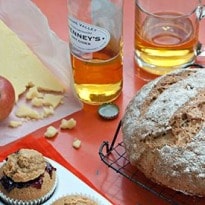Cider and baking don't sound like the most natural bed partners. But what a difference a splash of the former can make to cakes and bread
Some will nibble on a single square of single‑origin 85% dark chocolate once a day for a fortnight - moderating pleasure, feeling virtuous. I can't do that. Each time I discover, or am reminded of, some particularly delicious food, I eat it as much and as often as possible, until I can no longer bear the sight of it. It's not a sustainable hedonism, but it's a fun one. Most recently, it has been cider: I had a glass of a deliciously dry cider in the precocious spring sun some weeks ago, and since then I've been pouring the stuff into everything I cook. It works surprisingly well in baking, where its acidity lends a refreshing brightness to cakes and breads. I'll probably grow tired of it soon, but for the moment, at least, cider tastes as good as ever.
Spelt cider sunflower seed loaf
Cider gives this bread the acid hit that you might expect from a sourdough, in a fraction of the time. Because spelt flour's structure is different from wheat's, you'll need to handle this dough slightly less than you might usually, and take care not to let it rise for too long (otherwise it'll grow fragile and collapse before it even reaches the oven). As for accompaniments, I can think of no better way to serve this than with a few slices of cheddar, strong chutney and (what else?) a glass of crisp, cold cider.
Makes 1 large loaf
250g strong white flour
250g wholemeal spelt flour
7g instant dried yeast
1 tsp salt
1 tbsp honey
250ml dry cider
100ml water, hot
100g sunflower seeds
1 Combine the flours, yeast and salt in a large bowl. Separately, whisk together the honey, cider and hot water. The mixture should be tepid: if it's much warmer than this, leave it to cool for a minute or two before adding to the dry ingredients.
2 Add the cider and honey to the flour mixture and use your hands to roughly combine. At this stage, this bread differs slightly from many others: it needs only 1 minute of kneading, just until it begins to feel smoother and appears well-combined. Add the sunflower seeds and work lightly to incorporate. Place in a large, lightly‑oiled bowl, cover it with clingfilm and leave the dough to rise for 1 hour, or until approximately 1½ times its original size.
3 Turn the risen dough out on to a work surface and shape into a cob shape, gathering any "loose" dough underneath to give a taut, well‑rounded top. You could also shape it into a bloomer: roll, pat and pinch it into a slightly elongated rugby-ball shape. Leave to rise, covered loosely with clingfilm, for 45-60 minutes, or until it has grown in size by half again. Meanwhile, preheat the oven to 200C/400F/gas mark 6.
4 Dust the top of the risen dough with flour and use a very sharp knife to score the top, perhaps with a cross shape or a few horizontal stripes - this is to help give the bread room and a direction to expand.
5 Bake for 15 minutes before decreasing the oven temperature to 180C/350F/gas mark 4 for a further 30 minutes. Let it cool completely on a wire rack before slicing and serving.
Cider blackberry cupcakes
It makes sense that the autumnal, apple notes of cider would work well with blackberries. These cupcakes have deeply fruity, jammy centres to complement the cider-laced cake. The tops will have a rough-and-ready look to them once they've been dissected, filled and pieced back together again, but you can mask this with a slick of icing or a dusting of icing sugar if you're more aesthetically minded than me.
You could also divide this batter between two round 22cm cake tins and just sandwich the two with jam if you'd prefer a single, large cake. Throw a handful of finely chopped, toasted hazelnuts into the batter for even more flavour.
Makes 12
125g unsalted butter
175g light brown soft sugar
150ml dry cider
2 medium eggs
225g plain flour
½ tsp bicarbonate of soda
¾ tsp baking powder
¼ tsp salt
¼ tsp cinnamon
4-5 tbsp blackberry jam
1 Preheat the oven to 180C/350F/gas mark 4. Line a 12-hole bun tin with muffin cases.
2 Melt the butter over a low heat. Combine the sugar, cider and eggs in a bowl then whisk in the melted butter.
3 In a separate bowl, combine the flour, bicarbonate of soda, baking powder, salt and cinnamon. Add this to the wet mixture, whisking until smooth.
4 Divide between the muffin cases and bake for 20 minutes, or until a knife inserted into the middle of one comes out with just a crumb or two stuck to it. Let cool completely on a wire rack.
5 Once cool, use a small, sharp knife to cut a cone-shaped wedge of cake out of the centre of each one, leaving a hollow in the centre. Add a teaspoonful of jam into this hollow then place the cut-out piece of cake back over the top.
Photo: Cider gives this bread the acid hit that you might expect from a sourdough. Photography: Jill Mead for the Guardian.







